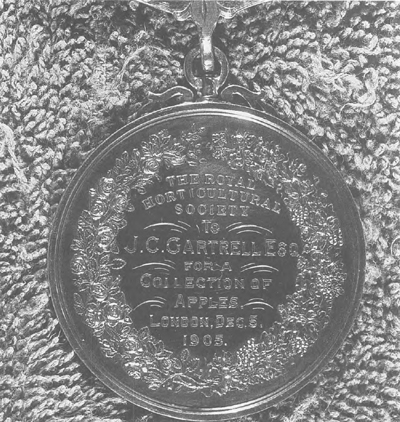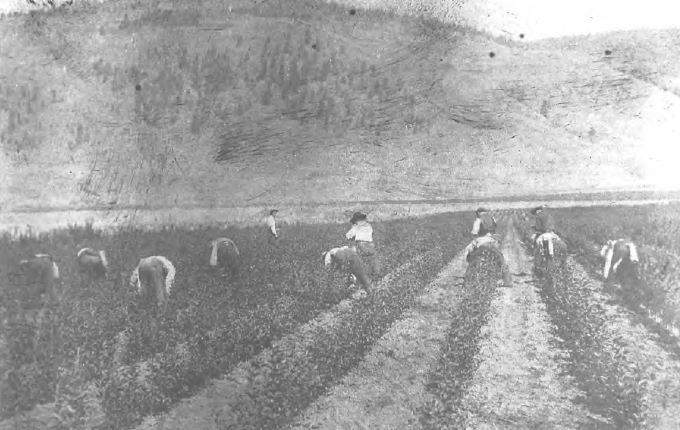News & Events More |
The British Columbia Fruit Exchange, LimitedEarly in its history the B.C.F.G.A. turned part of its concern from the growing of fruit to the marketing of it. At the 1890 convention a committee of directors recommended: that such members of the Fruit Growers' Association as are fruit producers, form themselves into a company for the purpose of disposing of their fruits, whereby a sufficient amount will be brought together to employ an experienced hand to look after the putting of it up for shipping, etc., and by thus having a standard brand of British Columbia fruit, and becoming known as producers and shippers of such, a market will soon be opened for all the overplus. Early in its history the B.C.F.G.A. turned part of its concern from the growing of fruit to the marketing of it. At the 1890 convention a committee of directors recommended: that such members of the Fruit Growers' Association as are fruit producers, form themselves into a company for the purpose of disposing of their fruits, whereby a sufficient amount will be brought together to employ an experienced hand to look after the putting of it up for shipping, etc., and by thus having a standard brand of British Columbia fruit, and becoming known as producers and shippers of such, a market will soon be opened for all the overplus. No action was taken in this direction, however, until 1895. By this time, local fruit marketing cooperatives had been formed at Mission and Chilliwack, and in that season the cooperatives could see the disadvantages of competing against each other in the Northwest market. E. Hutcherson of Ladner proposed that all shipping be done by a single central organization, and a committee of the B.C.F.G.A. was appointed to consider the matter and report to the 1896 annual meeting. Delegates from the local cooperatives and interested members of the B.C.F.G.A. met at the B.C.F.G.A. convention on January 30, 1896, and resolved to form the "British Columbia Fruit Exchange", a cooperative association to market the fruit of the province, to develop new markets and to act as the financial agent which would purchase supplies for local associations and growers. After considerable discussion about where the central shipping point was to be, a constitution and by-laws were adopted, and a provisional Board of Trustees was elected, with G.W. Henry of Hatzic as President and Manager.  Courtesy Mrs. Mary Orr The British Columbia Fruit Exchange commenced operations with the strawberry crop in May, 1896. Any local growers' union or individual grower could join; produce was gathered at various stops along the rail line and sold primarily on the Northwest market. A direct charge was made against each package to cover handling and shipping, and then payments would be made to growers based on pooled returns for each grade and type. The first season's operations, however, did not prove a great success. This was due in part to heavier than expected costs in setting up and operating the Exchange, and in part to losses caused by the piecemeal way in which fruit going to the Northwest was collected and transported. Plums already too ripe had to wait ten days for a carload to accumulate. The trip to Winnipeg then took six more days; the result was that a quarter of the fruit was unsalable and the net price received was less than was locally obtainable.* Nevertheless, enthusiasm for the Exchange was still high among members, and a proposal was made that the B.C.F.G.A. and the Fruit Exchange should be amalgamated, since the work ol the B.C.F.G.A. for the past year had been principally that of organizing the Exchange. "Mr. Henry thought the Fruit-Growers' Association had done some good work, but many seemed to think we could get along without it now; he thought it might be arranged to save expenses by carrying out the proposed amalgamation." Fortunately, in light of the subsequent history of the Fruit Exchange, the plan was dropped. The 1897 B.C.F.G.A. convention did vote to give $150 to the Fruit Exchange.  Budding apple stock at the Coldstream Ranch, about 1905. Courtesy Vernon Museum an d Archives The 1897 season was somewhat more satisfactory; shipments by the Fruit Exchange increased from a value of $5000 in 1896 to $19,500 in 1897, with apples being the major product, followed in order of importance by plums, pears, and strawberries. Returns to the grower were better than the previous year, running to two cents a pound for plums, sixty cents a box for early apples, and a dollar for late apples, figures which were stated to be twice what growers in Washington or Oregon received. But quality continued to be a major problem; one load of plums arrived in Winnipeg early in September. "The plums were not all in good condition when opened out, and consequently they had to sell at low prices, while some boxes were so badly off quality as to be practically unsalable." The dealers compared B.C. Budding apple stock at the Coldstream Ranch, about 1905. Courtesy Vernon Museum an d Archives fruit unfavourably to the better packing and quality of American fruit offered at the same time. B.C. growers were learning for the first time the lesson that it is not enough to grow good fruit; it must be handled properly and presented attractively if it is to sell well. 1898 was a heavy crop year, and the existing organization was simply not able to cope with it. For the first time, but by no means the last, the cooperative effort to stabilize the market and maintain prices was undercut by consignment selling. E. Hutcherson, who had replaced G.W. Henry as manager of the Fruit Exchange, complained that "early in the season we had contracts for fruit to be shipped regularly at fair rates, but later on telegrams kept coming in to us every day ordering us to discontinue shipping more, as fruit was obfainable from our own growers at much lower prices." The Kelowna Shippers' Union, for example, was shipping fruit to railway station and express agents to be sold for whatever it would bring. There were also further problems with poor packing and fruit arriving in poor condition. One dealer complained that "in very few cases does there seem to be the least care or thought exercised as to putting up the apples in an attractive state for the market. All the apples are seldom bad, but there is usually a sufficient portion of poor fruit to take the box out of the first rank, and to make it impossible to sell it for the highest price." The British Columbia Fruit Exchange was incapable of dealing successfully with the problems of a glut, and the organization collapsed. As late as February of 1899, growers were complaining that they had received neither payment for fruit they had shipped nor statements of what the fruit had realized. The Exchange ceased operations, and its history slowly wound down, ending in a tasteless wrangle as to whether its manager, E. Flutcherson, had diverted a payment of $300 from the B.C.F.G.A. to himself.6 Contact Us Hours: 9am - 4pm weekdays. t: 250-762-5226 |

